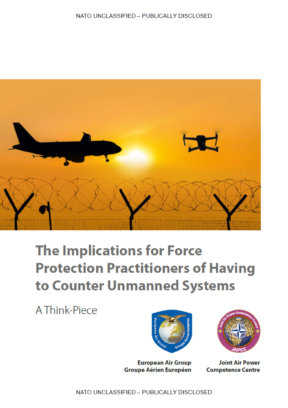Overview
The subject of Counter-Unmanned Air Systems (C-UAS) has become what can best be described as a ‘hot-topic’, not just for the North Atlantic Treaty Organization (NATO) but, globally. The primary question that this think-piece seeks to explore is whether this challenge is new and unique or, whether it is actually just one of many threats that NATO faces that can be addressed with a little intellectual effort and with existing technology or, novel use of existing technology?
Task Background
Supreme Headquarters Allied Powers Europe (SHAPE) as the Chair of the NATO Force Protection Working Group (FPWG), raised the issue of potential adversary use of UAS as an issue at the October 2017, FPWG in Brussels. The Nations subsequently endorsed a proposal that SHAPE should produce a Request for Support (RfS) to the Joint Air Power Competence Centre (JAPCC) to examine the issue with specific focus on the implications for the Force Protection (FP) practitioner. The need for this work was strengthened with the receipt at SHAPE, from Kabul, of a Crisis Response Urgent Operational Requirement (CUR). This CUR sought to address the question of how the migration of adversary tactics used in Iraq and Syria could be countered in Afghanistan and specifically, what can be done to mitigate adversary use of UAS, especially when weaponized?
Task Development
Subsequent to SHAPE issuing the RfS, NATO HQ Air Command (HQ AIRCOM), Ramstein convened its own FP Seminar to address the same issue. Given the SHAPE RfS, the JAPCC was asked to brief on its initial thoughts on the subject. In discussion following the brief, it was apparent that the JAPCC had effectively captured the essence of the challenge as perceived by both the NATO Air and broader Joint FP Communities and, what had not been captured, could be easily incorporated. It was also identified at the Seminar that both the European Air Group (EAG) and 1 German / Netherlands Corps (1GNC) were running their own similar projects. The pragmatic conclusion was that, with the agreement of the attendees at the Air FP Seminar and the EAG, the JAPCC would incorporate further discussion into the JAPCC work and subsequently make the resulting product available to a wider audience. Finally, the Air Force Interoperability Council (AFIC)1 were briefed on the work, and they too have now provided input. Therefore, this think-piece now represents the thoughts of a wide range of interested parties captured during the period 14 March – 21 December 20182. Of note, this paper was reviewed immediately after the 19 – 21 December 2018 disruption at London’s Gatwick Airport caused by apparent multiple ‘drone’ sightings. The thoughts reflected in this paper, it is offered, remain valid in light of this much discussed and publicized event.











